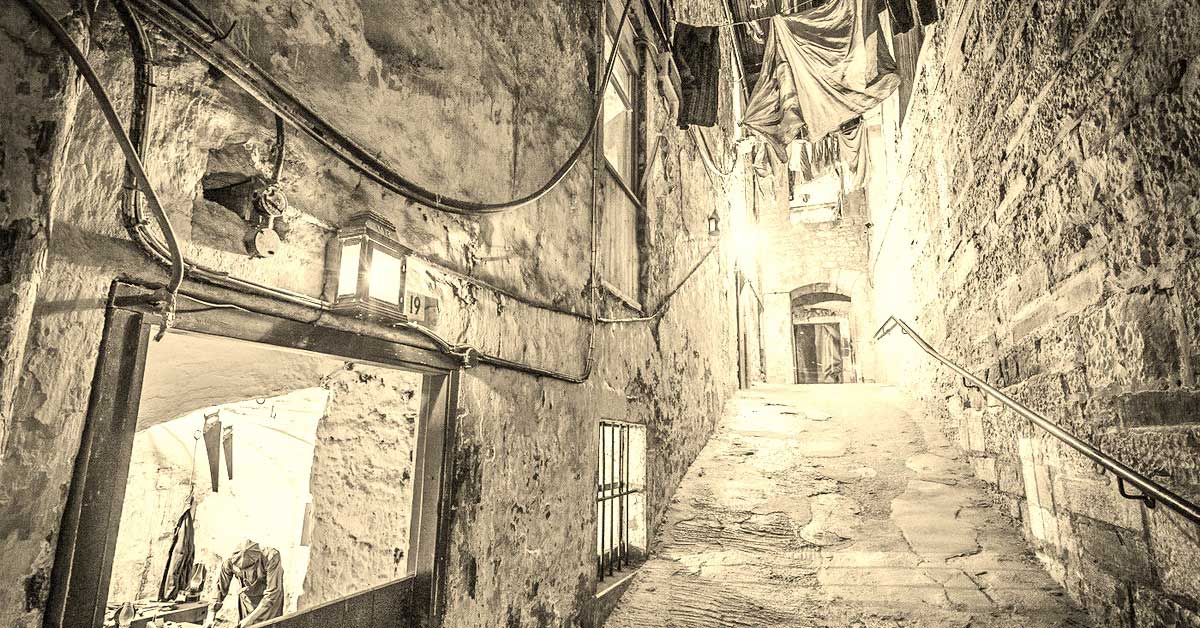
THE SWIRLING SPECTRES OF MARY KING’S CLOSE
Edinburgh is one of the U.K’s most popular tourist destinations. It has many grand Georgian buildings, smart shops, fine restaurants and cafes. Each August, it hosts the renowned Edinburgh Festival Fringe, the world’s largest arts festival. However, its main year-round attraction is unquestionably the castle that sits astride the city like a brooding giant. But like so many other cities, Edinburgh has a shadowy past, filled with mystery, murder and skulduggery. It is also a haven for the avid ghost hunter as it lays claim to being one of the most haunted cities in the U.K.
The area of Castle Hill has long been associated with bizarre apparitions, including a phantom coach and horses and that of a steely general who it is claimed has been seen galloping about the area on a white horse.
This steep, narrow passage tumbles down to the Royal Mile, the Old Town’s famous thoroughfare. Despite the friendly ambience in evidence today it was not always such a pleasant place. In the relative quiet of the gathering dusk, one can feel an immediate sense of being transported back through time to a grim page of the city’s history. This was a time when Edinburgh was populated with many murderous villains and grave robbers, such as the notorious Burke and Hare. Buildings were blackened with decay and the streets awash with the putrid stench of raw sewage. It was not long before the area became a breeding ground for disease.
The 17th century spelt catastrophe for the citizens of Edinburgh as the Great Plague of 1645 left tens of thousands dead. People became infected with this dreadful virus, accelerated by the growing numbers of rats that feasted on the sewage. One bite from the infected fleas, carried by the rats, spelt certain death within a matter of days. Thus the streets soon became rank with the stench of rotting corpses as the outbreak spread.
Many of the tightly-packed buildings in this area became abandoned altogether, particularly Mary King’s Close. Fifty years passed before anyone reoccupied any of these dwellings. It was around the 1680s that a law clerk, and devout Christian, named Thomas Coltheart and his wife, moved into one these formally dejected dwellings on the Close.
One Sunday, after attending church, Thomas retired to his room to rest, while his wife sat in devout silence in their living room reading her bible. She enjoyed these quite moments that always instilled a spiritual calm. However, on this occasion she began to have the irksome feeling that she was not alone. Never before had she experienced such a strange sensation, yet remained convinced that she was being watched. Looking about she could see nothing. Settling back into her chair she then raised her eyes and was instantly horror-struck. There, hovering above her was the disembodied head of a hideous old man with a long grey beard. The poor woman was so overcome with fear that she fell into a faint.
A short time later a neighbour called at the house and discovered her still splayed out on the floor. Fortunately, they were able to revive her. Although shaken from her experience she was able to recount what had caused her collapse. Her neighbour listened intently as she began describing the awesome apparition that had presented itself. Her husband, however, was less sympathetic and dismissed the episode, concluding it has merely been an aberration of the mind. He refused to be drawn further on the matter and suggested to his wife that she retire early and get a good night’s sleep.
That night, Thomas lay in bed with a smug smile on his face mulling over his wife’s ludicrous account of the disembodied head. He began questioning her sanity wondering what on earth could have come over her to imagine something so outlandish.
Thomas drifted into a deep and blissful sleep only to wake with a start in the early hours sensing a presence in the room. It was a clear night with the moon casting a pale, eerie light through the open window. The room then suddenly began to swirl around him as if a whirlwind had swept in. A feeling of utter horror overcame him for there, hovering above him, was the gruesome severed head his wife had spoken of. Thomas fell to his knees in silent prayer hoping this would purge the spirit that had invaded his home. However, his prayers were in vain for the repulsive head was soon accompanied by further weird manifestations of assorted body parts. These included a child’s head, a naked arm and even a cat and dog. This bizarre assortment continued to whirl about the room.
Incensed by this giddy gathering, Thomas, in his tortured state, began pleading with the spirits to explain their purpose, but the ghostly throng merely continued to prance merrily about the room. Suddenly a deep, mournful groan rent the air and, in that instant, the troublesome entities vanished.
Some weeks later Thomas began feeling unwell. What had at first seemed like a mere chill suddenly became increasingly worse. A terrible trembling overcame him, rattling every joint in his body. It was as if some evil, ethereal force had possessed his being and was torturing him from within. He then lapsed into a nightmare world, resurfacing only momentarily to speak of terrible visions of crows circling above him like dark scavengers of death. These terrible visions proved to be an omen of his impending demise. A short while later Thomas was dead.
Mary King’s Close was eventually closed up and all but forgotten. Many older residents thereabouts believed that were it to be reopened the plague would seep out and infect the city once more. Nevertheless, in 1992 it was reopened by the city council and no plague ensued. It did, however, provide an interesting feature on many of Edinburgh’s tours, offering a fascinating feature into the city’s subterranean world.
